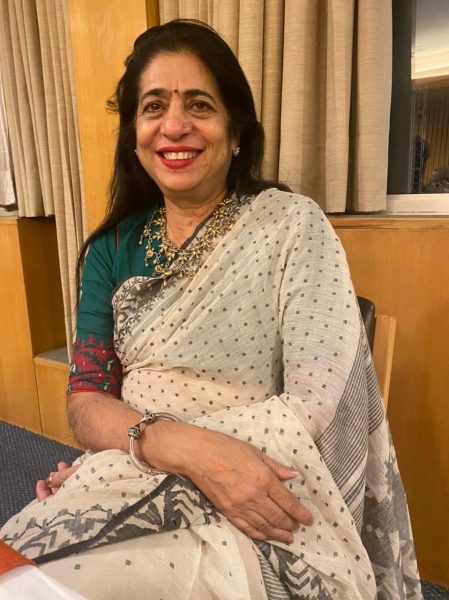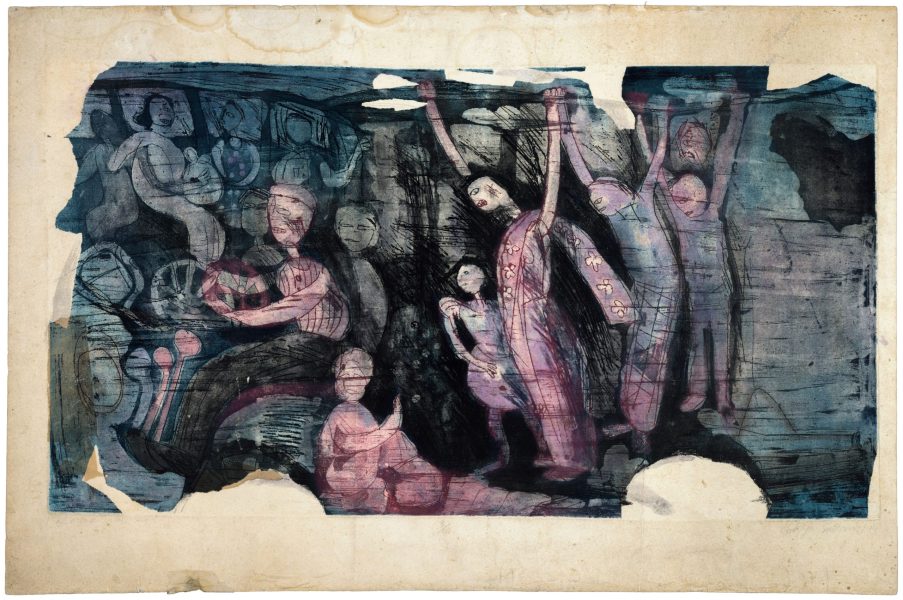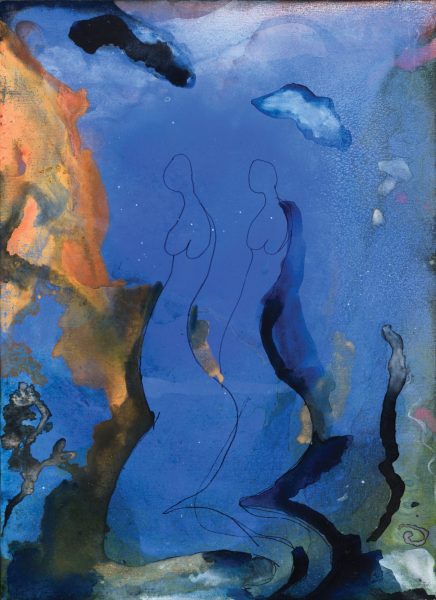

Bangladeshi artist Rokeya Sultana: I learnt humility, tolerance in Santiniketan

Eminent Bangladeshi artist Rokeya Sultana’s retrospective of her oeuvre spanning over 40 years, curated by Ina Puri, was held recently at the Lalit Kala Akademi in Delhi. It was organised to mark the celebration of fifty years of India-Bangladesh relations — it was slated for last year, but was postponed in the wake of the communal violence that broke out in Bangladesh during Durga Puja. The travelling exhibition also went to Kolkata and is on at Edge Gallery (‘Ode to Joy’) in Dhaka till September 17. In an in-depth email interview to The Federal, Sultana talks about her memories of Santiniketan, where she learnt under Somnath Hore, her artistic practice, why her works — enmeshed in the themes of womanhood, sensuality and feminism — are akin to the music that can establish the link between the human soul and the soul of the universe, and the shared cultural heritage of the subcontinent. Edited excerpts:
2021 marked the 50th anniversary of Bangladesh’s independence. Your journey is closely tied with the formation and evolution of cultural identity in an independent nation eager to forge its own path. In what ways did the tumultuous events of the 1971 revolution, which you witnessed as an adolescent, shape your artistic vision? Would you trace the themes of some of your works — loss, displacement and impermanence of life — to the ruptures in the wake of the second Partition in the history of the subcontinent?
Geographical boundaries can be breached and distance can be transcended through culture/art. This is a human reality. Artistic languages are readable across time and geography. All artists, thus, aspire to produce work of timeless value though their works are developed from within a geography and bear the signs of their own time. Artists are silent spectators and reveal things in a silent manner. The message the audience can take away from art is a matter of perspective as well as position. It is not contained within one language or belief. But art can be used to generate peace and even spread the message of peace. It can be shared to spread joy. It is at once a part of a given culture and the ability of the artists to transcend the bounds of culture.
Bangladesh is an independent nation and I think it is a matter of pride. And this pride definitely shines brighter in all aspects of our culture. The emergence of a new country in 1971 played a very important role in my life. Our family became embroiled in the war. My father was a district police superintendent. He resisted the Pakistani forces and played an important role in liberating the people of Pabna district.
I am one of the artists who witnessed the liberation war physically. On the afternoon of March 26, I remember my father telling us back from the police line as the police superintendent, even though he was talking to the adult members of the family. I heard some of it. Later, I came to know that the Pak army entered some neighbourhoods and killed people and humiliated and tortured many girls. I never saw my father so sad in my life and I heard him say that you cannot live with these demonic people, they are so bad — they are barbarians. That night the Pakistani army attacked the police line.
I remember that we left home with our mother and siblings after the war broke out. I see the liberation war in reference to my father, who helped mobilize the police force to resist the Pakistani junta. We later moved to India and my father took part in the liberation war and worked in Mujibnagar to free East Bengal from the clutches of the ogre. My works do not bear any obvious signs of atrocities, but they are informed by the sense of freedom as well as the sense of responsibility that came with freedom.

How do you see your connection to your homeland informing your artistic consciousness and determining the evolution of your work?
I was born into a traditional, historically rich culture. This is how I see my homeland. The ethos that have been nurtured by a people for many years are reflected in my work. My work on water, soil, air is basically about the nature of the alluvial plain and the experience of a people who have been living here for thousands of years. But the way I see and feel my homeland and bring those to my canvases bespeak my own understanding of the land and people. My artistic expression that evolved over the years also negotiated modern idioms developed after the modern state emerged. My artistic strategy can also be seen as an internationally recognized strategy though I have drawn from this soil. I see the whole world is being accommodated within what is Bangladesh. Like my Madonna series, which has universal appeal, but tells the story of a mother and a daughter. Here, the story of a middle-class life has been transformed into the universally recognized relationship between a mother and her girl child.
Could you describe the cultural atmosphere of Dhaka and its art movements in the early 1980s? At a personal level, what governed your choice to study printmaking?
The practice of printmaking in Bangladesh has already reached the standards of modern art, which is a global movement. After the partition of Bengal in 1947, artist Safiuddin Ahmed and artist Habibur Rahman moved from Calcutta to the then East Bengal, now Bangladesh. After the inception of Dhaka Art College in 1948, printmaking was practised through woodcut as a major medium. Later, it was widely practised through lithograph, etching, aquatint, plate-lithography, collagraphy and other mediums. Extensive progress has also been made in perfecting the application of these mediums. A number of talented artists of that era (1947-61) received advanced education through various means of printmaking from abroad. And they have been able to establish a distinct style exploring different subject matters and style of printmaking in this country. Safiuddin Ahmed is a the pioneer of modern printmaking in Bangladesh. Among the best artists from Bangladesh are Mohammad Kibria, Monirul Islam, Rafiqun Nabi, Abul Barq Alvi, Biren Some, Shahid Kabir and others. Before that Zainul Abedin laid the ground for a modern practice that continues to negotiate the people and its traditions. I began my student life at Dhaka’s modern art institution in the first batch of the years 1975-8 in the printmaking department.
Zainul was the epitome of the man of the soil, who paid due attention to all the rural cultural and artistic achievements of this fertile delta centered on the agrarian life. Our generation imbibed all those cultural aspects relating to traditional lifestyle and then added to them the aspects of modern life. So Pala Parvan, Bhatiali, Bhavaya songs are our basic materials upon which the edifice of modern art is based.
You studied MFA at Santiniketan where your mentors included the likes of Somnath Hore, Sanat Kar and Lalu Prasad Shaw. What memories do you have of Santiniketan? What were your greatest learnings from your mentors?
In Santiniketan, I learned humility and tolerance. The open deserted land of Santiniketan has taught me to be generous. The humanistic spirit of Santiniketan linked to the universal ideas of Rabindranath inspired me to be a better person. I have learnt the basics of style from Somnath Hore, which are about shapes and forms. I have learnt colour from Sanat Kar; he also taught me how to harness desire, how to capture that elusive dreams we dream. Lalu Prasad made me aware of composition, balance and sensitivity with which to approach all subject matters.
Your artistic practice began in earnest in the 1990s. Over the last 40 years, you have been able to create a new symbolic personal language, dominated by dynamic colours and flowing, rhythmic lines, and have worked extensively with colours, lines and figurative images. What governs your choice of form for a particular work?
The answer to this question is already in your question. My forms have always been fluid and with subject matters, which are primarily human and animal forms. I have always been very playful. Many unseen things, such as many forms of the solar system have entered my oeuvre over the years. A lot of things are emerging around me; a lot of forms that we don’t see with the naked eye are also there as they are associated with feelings.
Self-realisation and your lived experience are at the core of your aesthetics. The various aspects of being a woman as well as the experience and perception of the sensory world from a woman’s standpoint have been the materials that have made up a large part of your oeuvre, as evident in Relation and Madonna series of works. Do you see them as feminist statements?
Bangladesh was once part of India. My parents came to this country after the partition in 1947. My father was the only member of the family. His parents, siblings decided not to leave Kolkata. I have witnessed the pain of losing one’s homeland. The reason I say this here today is because in y art has always been informed by the life I lived and my parents’ sense of loss of the land and the pain of forced migration have come and gone in many ways.
My mother used to tell the story of her homeland when I was a child. She never met her mother again, and the agony of separation remained with her all her life. She used to describe vividly her life in West Bengal, remembering her father, mother, sister and even the family doctor. She used to talk about the ducks, chickens, goats, dogs, and cats, etcetera. She used to talk about a particular story of a tiger coming to a dormitory. Her words unspooled a world akin to that of a fairytale. Many histories and traditions are transferred from one generation to another following this paradigm of storytelling. I imbibed a lot from these fairytale-like stories — be that the emotional colour or the indomitable spirit of the humans to continue their life in form or another. They seemed like fairytales to me because I had never seen that village my mother described and never thought that I would ever go there and witness in real time.
By following the footstep of my mother, the primal Madonna, I became Madonna after I gave birth to my own daughter. My mother’s stories have found their way into my paintings in many ways — in metaphorical forms, in exuberant colours and fluid forms. The Madonna series was a turning point in my life. I would not call them feminist statement as they did not carry any such zeal and also since they are a testimony of a mother-woman who values the link between generations which feminists care little about.

In your non-representational work, we get to see your deep engagement with ecology and nature. Do you think artists need to be more invested in the physical condition of the natural world in the face of the ecological crisis that is acquiring increasing urgency?
Yes, there is a holistic approach to them as they are informed by many things, including Quranic recitation I often listen to.
I have a series which explores the idea of the three most essential elements in our life — Water, Earth, Air. Bangladesh being the land of rivers, and as it is one of the most fertile lands in the region, it has been the home to many sages and sufis — fakirs, mendicants and folk bards who lived by the rivers and spoke about the primordial element that is water. They expressed their life’s ebbs and flows through devotional songs. Even the ‘bhatiali’ and ‘bhawaiya’ genres of songs are linked to the land and the water that formed its character. My work is a reflection of their lives on a spiritual level. When I use tempera, I make the colours myself using different pigments. The layers of colours represent the generations that have come and gone, memories that can never find their way into the narratives that we refer to as history. The sense of the past seems so alive to me that time also seems fluid. My abstract works can be seen as the rhythm of the life that are long gone, the ideas of the whole that we encounter in the Quran as they get translated into the rhythm of the songs of ‘bauls’ or sufis. In short, they are mostly about the music that can establish the link between the human soul and the soul of the universe.
Another of your series, Fata Morgana, explores the link between perception and reality, drawing on the unusual mirage that can be seen from both land and sea. How will you define your own relation with land and sea?
The series, Fata Morgana, which means mirage at sea in Italian, is unique by many aspects. Firstly, the prints are made using a series of new techniques that I learnt during my Fulbright scholarship at the University of Nebraska-Lincoln. I call the technique monotype pressure print and even though they are technically prints (which means that they are multiples) they are one-off prints because their exact identical reproduction is impossible. There is a hard edge to them which makes it possible for all to notice an innovativeness of the series. Through the shapes and lines and their organizational quality a new spirit is brought forth. They somehow manage to emphasize the mystery of the everyday life, centering on what the artist calls her inner cosmos, while it also pushes the image towards the great mystery surrounding birth and death. To talk about the changeful imageries, I can say that migration played an important role in my life and art. My father left Kolkata and came to Dhaka and his job took him to several districts across Bangladesh. So, as I was growing up, I developed a sense of time and life as transient. Perhaps Fata Morgana seems to draw on that transient spirit.
Do you see the art scene in Bangladesh as more conducive to women now than it was in the 1980s? How do you look at the works of some of your contemporaries, like Akhtar Jahan, Dilara Begum, Fareha Zeba, Nasima Haque?
Yes, the present scene in Bangladesh is more conducive to women. The situation has improved over the years since I began than the 1980s.
And my contemporaries are doing great. Dilara Begum is one of my favorite artists. She is working on contemporary issues while focusing on the disasters we have been met with in the garment sector over the years. Artists such as Nilufar Chaman and Nazli Laila Mansur, too, have been consistently producing art that have left an impact on the mainstream.


